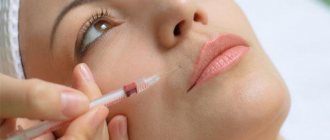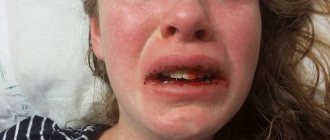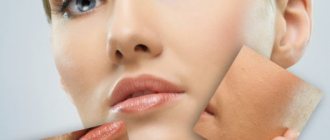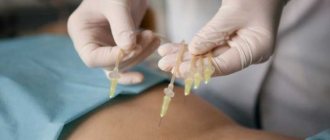Recently, the journal Expert Opinion On Drug Safety published an article by gynecologists from Taiwan who reviewed the use of BTA in pregnant women, and the doses of botulinum toxin were therapeutic and used in patients to treat neurological diseases1.
All of these conditions were successfully treated both before and during pregnancy with BTA injections, which allowed doctors to monitor the effect of botulinum toxin on the course of pregnancy and the effect on the fetus. Scientists say BTA injections have shown relative safety during pregnancy.
Below we provide excerpts from the material.
Botulinum toxin in the systemic circulation
To begin with, we should remember: in order to act on the myometrium or reach the placenta and negatively affect the fetus, the active substance must enter the systemic circulation.
Some reports indicated that, at high doses, BTA could diffuse from facial muscle tissue into the arm, as measured by single-fiber electromyography (EMG)2, 3. However, this effect appeared to be subclinical because no muscle weakness was detected in the affected individuals. If the dose of the drug did not exceed the recommended one, then during intramuscular injection BTA did not enter the systemic circulation4.
BTA is classified by the FDA as a Category C drug, which means that animal studies have shown adverse effects of the drug on the fetus and there have been no adequate studies in pregnant women, but the potential benefits associated with the use of this drug in pregnant women may justify its use despite existing risk.
In addition, studies have shown that molecules larger than 500 Daltons cannot cross the placenta5. The molecular weight of BTA exceeds 500 D, so BTA is unlikely to cross the placental barrier and is unlikely to be present in fetal blood.
To date, animal studies have found no evidence for transmission of toxins to the fetus. In rabbits, BTA was not detected in the placenta or in embryos when high (lethal) doses of the toxin were administered intravenously. Malformations and abortion were recorded only if rabbits received high-dose injections of BTA daily; conversely, pregnant mice treated with BTA did not show similar adverse outcomes6.
Precautionary measures
If a woman still cannot do without the Botox procedure, and she decides to give preference to it, it is worth knowing about some precautions to avoid negative consequences. The main reason for the occurrence of consequences after the Botox procedure is incorrect technique, lack of knowledge of certain rules, as well as the selection of a low-quality product.
During pregnancy, a woman’s body is as vulnerable as possible, so it is worth giving preference exclusively to high-quality and proven products that will not cause an allergic reaction or in any way affect the child’s body.
Professional cosmetologists today highlight several options for the best products that you should pay attention to when choosing Botox:
- L'oreal - this Botox contains keratin, which quickly straightens hair, gives it shine, beauty and radiance;
- Honma Tokyo - characterized by a natural composition, has the most beneficial effect on the body;
- Kallos is a European hair product, used primarily for home treatments.
If you are pregnant, you should definitely consult with a specialist who will determine whether such hair manipulation can be carried out at this stage and whether it will be dangerous. Only increased attention to yourself and to the health of your unborn baby will eliminate any consequences and side effects after Botox.
Dystonia
Dystonia is a syndrome in which there is a constant spasmodic contraction of muscles, spasms are often unpredictable, change the normal position of the body, can be chronic and cause significant discomfort, pain and disability.
Article 1 examined the use of BTA in the treatment of idiopathic torsion dystonia, oromandibular dystonia, and spastic dystonia (Table 1).
As a rule, the disease begins before the onset of reproductive age and persists throughout life. Common in pregnant women. Currently, BTA injections are the preferred treatment option. Moreover, in 10% of patients the disease began suddenly in connection with pregnancy and childbirth. Ankola showed (a study of 350 patients) that pregnancy or pregnancy-related hormonal changes may be a risk factor for the disease7. Morgan found that in a survey of 396 doctors, nine pregnant women received a BTA injection during pregnancy. One patient had a spontaneous abortion, but the other eight patients gave birth to healthy children8. Blitzer11 summarized the data of 1300 patients with dystonias such as adductor and abductor dysphonia, and over 24 years, according to his data, the effectiveness of BTA was 91.2% and 70.3%.
Table 1.
Use of BTA for the treatment of dystonia during pregnancy (according to Wu Li, Min Tang1)
| Study | Number of BTA injections | Dosage/Duration of treatment | Result |
| Newman, 20049 | 3 | 15 weeks / 200 units. 21 weeks / 100 units. 32 weeks / 300 units | BTA improved the symptoms, which recurred approximately every 3–4 months. Over the next 9 years, the patient became pregnant three times and received BTA several times during each pregnancy. The injections gave good results in all three pregnancies, the patient gave birth to healthy children |
| Aranda et al.10 | 1 time in the second and third trimesters | The injection site and dose were identical to those used before pregnancy: 40 IU into the left sternomastoid muscle, 150 IU, and an additional 60 IU divided between the trapezius and right elevator scapula muscles. The total dose during pregnancy is 500 IU. | At the 40th week, the patient gave birth to a healthy baby (weight 3400 g). |
| Morgan8 | _ | _ | The patient experienced relief of symptoms and gave birth to a healthy baby20. |
What is biorevitalization?
Unfortunately, with age, every woman notes that the condition of her facial skin deteriorates significantly. The skin becomes dull, faded, various wrinkles and age spots appear, elasticity and overall tone decrease.
Biorevitalization is a cosmetic procedure that involves injecting hyaluronic acid under the skin in problem areas. This substance is actively used in modern cosmetology because it has the unique property of actively moisturizing the skin and preventing cells from losing their own moisture. As you know, many age-related skin problems are associated with dehydration. Hyaluronic acid perfectly replenishes the water balance of the skin, which very quickly affects its appearance.
When completing a course of biorevitalization procedures, the result is visible immediately. After the first injections, wrinkles are smoothed out, the skin is evened out and takes on a healthier appearance. However, the main effect will occur a little later, after 1-2 weeks, when skin cells adapt and begin to produce their own active substances. Therefore, you should not evaluate the effectiveness of the procedure immediately after it is carried out.
The main indications for the course of procedures are:
- dry facial skin;
- skin that has lost vitality, healthy appearance, elasticity;
- the need for recovery after surgery (including after plastic surgery);
- strong skin pigmentation;
- consequences of excessive exposure to UV rays.
There are two methods of biorevitalization - injection and laser. When injected, as already indicated, hyaluronic acid enters the cells through microinjections. With the laser method, a special active gel is applied to the skin of the face, which penetrates the skin cells under the influence of the laser. This method is less uncomfortable, but the number of procedures is greater, so the effect will be somewhat later than after injections.
Biorevitalization during pregnancy – is it possible?
Many women, having started a course of biorevitalization before pregnancy, think about continuing these procedures while carrying a child. Of course, it is quite natural that an expectant mother wants to look good and attractive. However, any cosmetic procedures should be selected based on the safety of their effects on a growing baby.
Unfortunately, biorevitalization is not performed during pregnancy, as it may be unsafe. Therefore, when planning a pregnancy, a woman should think about when her planned cycle of cosmetic procedures will end, so that there are no overlays and she does not have to interrupt the course. The best option would be to stop visiting a cosmetologist before pregnancy - then the long-lasting effect of biorevitalization will delight the expectant mother in an interesting position for a long time.
The ban on this procedure during pregnancy is not accidental. Aggressive cosmetic methods of facial skin care are generally not recommended for pregnant women, and biorevitalization is no exception. First of all, if we are talking about injections, then this procedure can be quite painful, and it is advisable for expectant mothers to avoid all unpleasant effects.
Despite the fact that hyaluronic acid is a safe drug, an individual negative reaction to it is possible. Even if a woman has already taken similar courses before pregnancy, changes in hormonal levels, decreased immunity and complex restructuring of the body can lead to intolerance.
Of course, if the procedure is carried out by an experienced cosmetologist in compliance with all necessary sanitary requirements and sterility, then the likelihood of side effects is extremely low. However, the possibility of inflammation cannot be completely ruled out, and during pregnancy a woman’s immune system does not work as intensively. Both the presence of inflammation and its further treatment with medications can have a negative effect on the fetus.
Many pregnant women often experience skin hyperpigmentation. This phenomenon is temporary and goes away on its own after childbirth. Hyaluronic acid can enhance such manifestations, which is unlikely to please the expectant mother.
Well, in the end, it should be noted that there is no reliable data on the absence of a negative effect of hyaluronic acid on the fetus; this issue has not yet been deeply studied.
Strabismus
Deviation of the visual axes from the direction towards the object in question, in which the coordinated work of the eyes is disrupted and it becomes difficult for both eyes to fixate on the object of vision. BTA is considered an alternative to surgery.
Table 2.
| Study | Number of BTA injections | Dosage/Duration of treatment | Result |
| Morgan, 20048 | Two patients with strabismus received BTA during pregnancy | 1.25 to 300 IU | The therapeutic effect did not cause complications or fetal abnormalities |
| Lee Yim12 | 17 year old woman. The drug was administered before the patient knew she was pregnant | 2.5 IU | A healthy baby was born |
Advice from cosmetologists and gynecologists
What should an expectant mother do to ensure maximum safety for newborns:
- maintain a balanced diet;
- use special vitamin complexes;
- use natural masks with the addition of olive oil, which increases skin elasticity and helps eliminate stretch marks.
- massage problem areas.
Women need to think about the effects of Botox, especially if they are planning a pregnancy or are pregnant. After all, even the use of ordinary drops for the common cold requires a detailed study of the instructions for use. In the case of the drug in question, responsibility for the consequences lies almost entirely with the patient, since injections are given with prior consent.
Esophageal achalasia
Functional obstruction of the esophagus. Characterized by loss of lower esophageal sphincter (LES) activity and esophageal motility; the main symptoms are dysphagia, chest pain and reflux.
Treatment options include diet, calcium channel blockers, and Heller myotomy. BTA can be injected locally into the stomach area. The procedure does not require deep anesthesia, and can relax the LES and relieve esophageal obstruction.
Table 3.
| Study | Number of BTA injections | Dosage/Duration of treatment | Result |
| Wataganara et al., 200913 | From 18th week | 80 U BTA | A healthy infant was born at 36 weeks' gestation and no swallowing problems were noted until 6 weeks postpartum. |
| Hooft 201514. | BTA at 14 weeks of pregnancy | 100U | Healthy baby |
| Holliday 201615 | BTA at 31 + 3 weeks of pregnancy | – | Eclampsia and childbirth at 37 + 4 weeks of pregnancy |
Chronic pelvic pain (CPP)
A common syndrome with various causes: the main and only symptom is pain, sometimes accompanied by defecation disorders. In addition to daily pain, patients often complain of dyspareunia and dysmenorrhea. In women, pain was significantly reduced after BTA injections.
Table 4.
| Study | Number of BTA injections | Dosage/Duration of treatment | Result |
| Abbott 200616 | 30 | 80 IU | Two women became pregnant 4 and 5 months after the injection; One woman (41 years old; complex medical history) had an elective caesarean section at 40 weeks and the baby had a ventricular septal defect that required surgical correction. However, it is unclear whether it was caused by BTA administration. |
| Abbott 200917 | Two cases during pregnancy | – | Both mothers had good results. |
How do beauty injections work?
Botox injections
Botox is very popular among women. It helps restore youth. The effect is achieved by administering an injection containing a small concentration of botulinum toxin, produced from botulism bacteria. This substance blocks the nerve endings of the muscles, due to which wrinkles are smoothed out without surgical intervention. After 3-5 months, the effect of the injection ends. After this period, many women turn to a cosmetologist.
The main purpose of Botox is to combat various diseases. It is used for spasm of the eyelids or half of the face, cervical dystonia, convulsive curvature of the neck, excessive sweating from the armpits and other pathologies. This injection is administered for dyshidrosis. Its main goal is to cause paralysis of the muscles, the improper functioning of which leads to the development of the disease.
It has been proven that beauty injections can cause malfunctions in the body. So, scientists conducted a study: 320 people were given Botox injections. 4 of them developed a migraine that did not go away during the day and lasted from 2 to 4 weeks. Thus, the administration of botulinum toxin is fraught with side effects. Moreover, most women who rejuvenate themselves with injections experience a mild and short-lived headache.
If such consequences are found in ordinary people, then what about pregnant women? During gestation, the load on the body increases, which is fraught with a more acute reaction to certain drugs. An expectant mother who has received a Botox injection may experience pathologies such as allergies, dizziness, digestive problems, and shortness of breath. The fetus can also suffer from beauty injections.
Migraine
Some migraine medications are considered unsafe for pregnant women18.
In 2000, Binder et al were the first to report that BTA was successfully used in patients with headache19. In a meta-analysis of 17 studies involving 3646 patients with chronic migraine, Brula et al found that BTA significantly reduced chronic migraine symptoms after 3 months of treatment compared with placebo; therefore, BTA was considered safe and well tolerated20.
Complication statistics
Wu Li, Min Tang1's findings on complications showed that rates of spontaneous abortion and fetal malformations in pregnant women treated with BTA were similar to those reported for the general population.
Tan reported 28 cases occurring before 2013 in patients who received BTA during pregnancy; including 25 normal births, 1 therapeutic abortion and 2 spontaneous abortions21.
In 2020, Brin et al. reported results in pregnant women who had received local injections of BTA within the previous 24 years. Of the 137 births (139 fetuses), 110 (79.1%) were live births, 29 (20.9%) were fetal loss (21 spontaneous abortions) and 8 abortions22. Among the live births, 106 (96.4%) were normal, only 4 patients had a poor outcome, two had minor fetal malformations and one congenital complication; the overall incidence of fetal malformations was 2.7%. They may not have been related to BTA treatment.
The effect of Botox on pregnancy: the opinion of a cosmetologist
“I cannot tell you that it is unsafe, but I can boldly say that it is not recommended to do the procedure during pregnancy,” says the cosmetologist. “During pregnancy, our general premise is that any type of medical treatment or intervention that is worth the risks can be used. But there is no medical justification for using Botox during pregnancy."
The lack of research into the use of Botox during pregnancy should be a deterrent, said the obstetrician, who said the injections are strongly discouraged during this period.
If we are talking about women who received an injection before conception, it is unknown whether there will be negative consequences for the unborn fetus.
Botulinum poisoning
There have been cases in the literature where high doses of BTA could cause symptoms of systemic botulinum poisoning.
However, a report by Brin et al. (2016) states that clinical botulism has no adverse effects associated with pregnancy or the fetus22. Badell studied maternal and fetal outcomes associated with botulinum poisoning in 16 women during pregnancy (11 cases in late pregnancy) and 1 woman after injection23. Although the pregnant women showed signs of poisoning, all babies were born healthy and only six patients experienced premature birth. Newborn blood tests did not show the presence of BTA in the systemic circulation; these findings also supported the hypothesis that BTA does not enter the fetal circulation24,25.
Dysport injections: indications and contraindications
Before deciding to carry out rejuvenation procedures using beauty injections with drugs such as Dysport, Botox, you should consult a doctor and become familiar with the indications and contraindications.
In the OB clinic salon, Moscow, you can get detailed advice from highly qualified specialists. They will help you make a choice, or offer alternative rejuvenation options, instead of introducing Dysport before pregnancy. They will also cover in detail a number of issues:
- Is it possible to inject Dysport if planning a pregnancy is planned in the near future;
- Is it possible to use Dysport during pregnancy?
- Is it permissible to administer Dysport during lactation, and at what time is it better?
The main indications for the procedure may be:
- the first signs of age-related changes;
- vertical wrinkles between the eyebrows;
- the presence of crow's feet in the corners of the eyes;
- deep wrinkles in the forehead, on the bridge of the nose and other changes that the cosmetologist will suggest.
The cosmetic procedure has the following contraindications:
- age restrictions of patients (under 25, or over 65 years);
- infectious, chronic diseases in the acute stage (HIV infection);
- recently after surgery, stroke, heart attack;
- period of breastfeeding, pregnancy;
- blood diseases, poor clotting;
- taking antibiotics;
- allergic reactions, individual intolerance to components;
- neuroses, stressful conditions.
Every woman at any age and condition cannot be indifferent to her appearance when wrinkles appear, so expectant mothers still wonder whether it is possible to inject Dysport during pregnancy, and what effect of Dysport during breastfeeding can manifest itself on the body of mother and baby?











